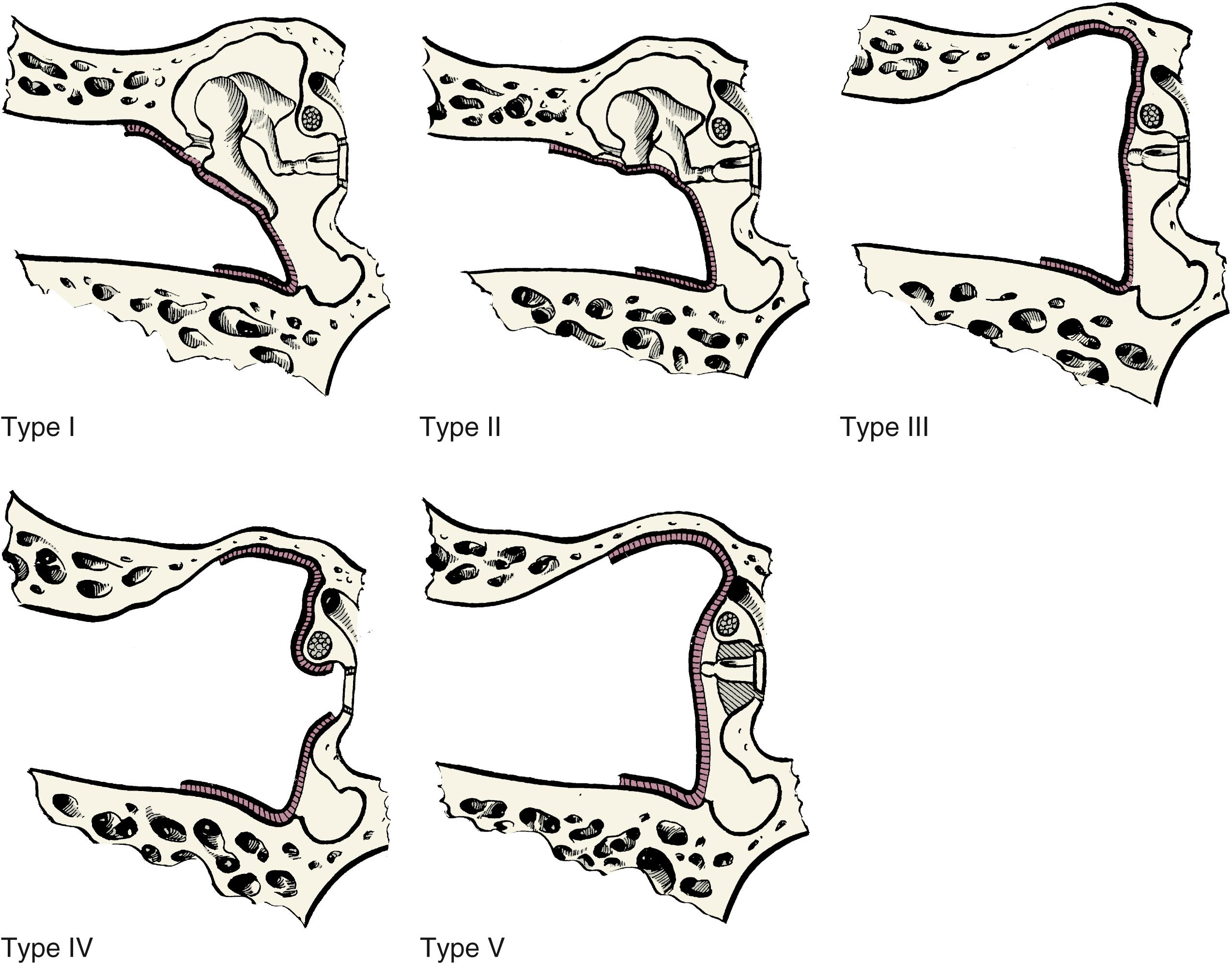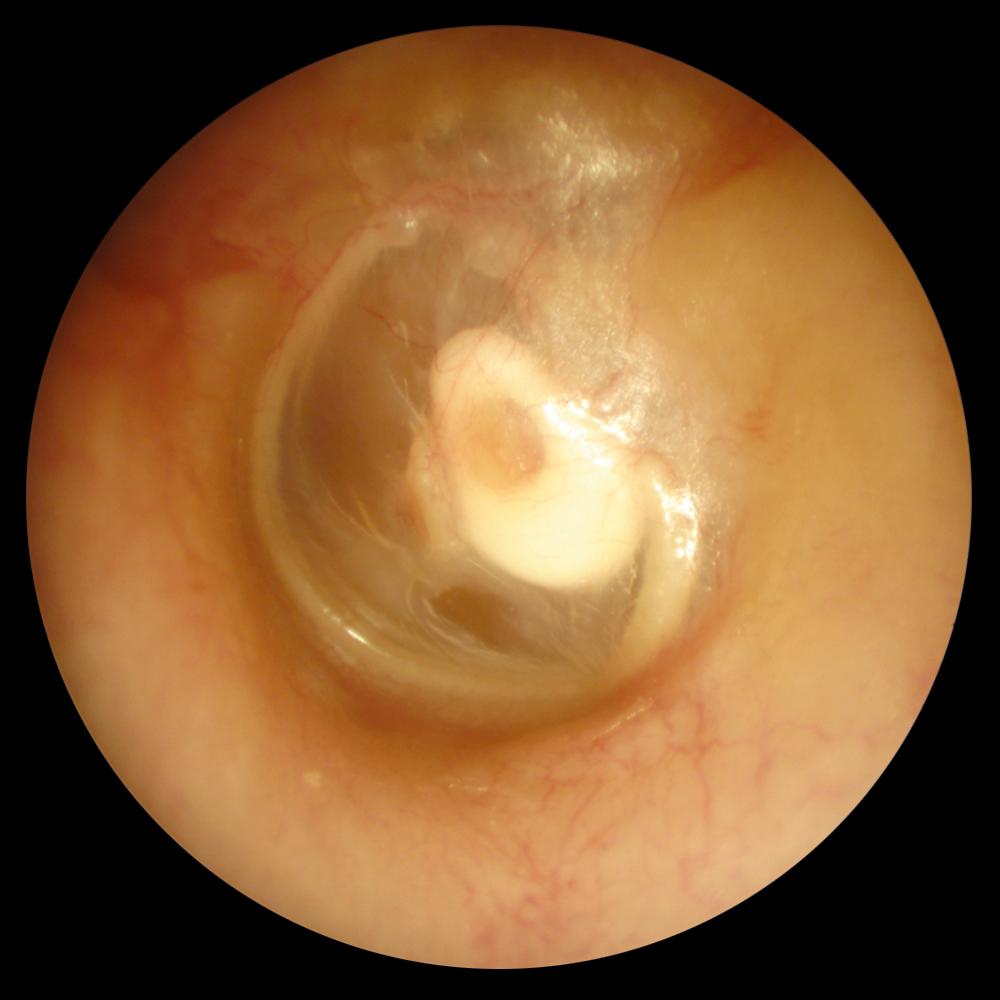Physical Address
304 North Cardinal St.
Dorchester Center, MA 02124
Conductive hearing loss results from restriction of sound wave energy in displacing the basilar membrane of the organ of Corti. Conductive hearing loss not of middle ear or tympanic membrane origin can result from obstruction in the external auditory canal and possibly from fluid distention within the inner ear, such as that seen in early Meniere’s disease. Inner ear conductive hearing loss also occurs when a “third window” exists in the otic capsule. Dehiscence of the superior semicircular canal provides a site for expansion of inner ear fluid, which prevents the fluid wave from providing full stimulation to the basilar membrane of the cochlea. This may result in conductive hearing loss even though acoustic reflexes will still be present.
Conductive hearing loss of middle ear origin may be congenital or acquired and results from ossicular chain fixation, erosion, dislocation, or fracture. Mass effect from reactive soft tissue processes, tumors within the middle ear, and cholesteatoma can also dampen the transmission of sound energy to the oval window. Ossicular chain reconstruction (OCR) reestablishes the sound-transforming mechanism to provide a mobile connection from the tympanic membrane through an aerated middle ear space to the perilymph via the oval window. This chapter focuses on the surgical techniques for OCR. Tympanic membrane grafting, surgery for stapes fixation secondary to otosclerosis, and chronic otitis media with cholesteatoma are addressed in other chapters ( Chapter 131, Chapter 133 ).
The term tympanoplasty describes procedures that address the status of the middle ear from the tympanic membrane to the vestibule. OCR is frequently performed in conjunction with tympanic membrane grafting for eliminating middle ear and mastoid disease. Zollner and Wullstein were early pioneers in the concepts of middle ear reconstructive surgery. Wullstein provided a classification system consisting of five types (I to V) of tympanoplasty that focus on reconstruction with the remaining ossicular chain. Each type refers to the most lateral intact structure that remains connected to the inner ear on which the tympanic membrane is grafted or the ossicular chain reconstructed. Type I tympanoplasty indicates that all three ossicles are present and mobile. Thus, OCR is not needed. In type II tympanoplasty, the tympanic membrane is grafted to an intact incus and stapes. In practice, the need for type II tympanoplasty is rarely encountered. According to Wullstein, a type III tympanoplasty exists when an intact mobile stapes superstructure is present and the tympanic membrane or graft remains directly on the stapes superstructure. Type IV tympanoplasty describes an absent or eroded superstructure, with the graft or tympanic membrane lying on a mobile stapes footplate. Type V tympanoplasty refers to a fenestration created in the horizontal semicircular canal ( Fig. 132.1 ), a procedure no longer in active use today due to the superior outcomes afforded through other techniques—largely as a result of modern instrumentation, the otomicroscope, and a wide array of readily available commercial prostheses.

Use of this classification system was subsequently encouraged by Farrior, who clarified the terminology by basing the type of OCR on the pathologic anatomy at the completion of surgery rather than the method of reconstruction used. According to Farrior, type III tympanoplasty refers to establishing continuity of the stapes to the more lateral tympanic membrane or malleus by interposing a sculpted ossicle, bone, or other alloplastic material. A type IV tympanoplasty denotes reconstruction of the ossicular chain from a mobile stapes footplate to the malleus, tympanic membrane, graft, or, rarely, the incus. Type V tympanoplasty has been subdivided into types Va and Vb. Type Va designates a true fenestration procedure into the horizontal canal, whereas type Vb implies that the footplate is fixed or absent. After the vestibule is sealed with a tissue graft, continuity is restored from the oval window to the incus, malleus, tympanic membrane, or graft. Technically, stapedectomy would be characterized as a type Vb tympanoplasty, but this terminology is not proposed for otosclerosis surgery.
This classification system is supplemented by describing the method of reconstruction used for each case. This is applied particularly to type III tympanoplasty. A frequently performed type III tympanoplasty is an incus interposition with the patient’s own incus (autograft). A type III tympanoplasty with stapes augmentation entails increasing the height of the stapes above the Fallopian canal when a canal wall–down mastoidectomy is performed and the malleus is absent. This technique frequently uses the body of the incus, the head of the malleus, or a cortical bone graft. The term partial ossicular replacement prosthesis (PORP) is used when a synthetic biocompatible prosthesis is positioned from the stapes superstructure to the tympanic membrane, graft, or malleus. Types IV and Vb tympanoplasty are performed with either a total ossicular replacement prosthesis (TORP) or the patient’s own incus from the footplate or grafted oval window to the malleus, tympanic membrane, or graft.
The surgeon should be prepared to manage all reconstructive problems within the middle ear by being familiar with the various techniques for OCR, should unanticipated problems arise.
Careful palpation plus inspection of the tympanic membrane and all ossicles is critical for determining whether myringosclerosis and tympanosclerosis, separately or in combination, have caused the conductive hearing loss.
To avoid restriction of movement, an interposed ossicle or prosthesis should not make direct contact with the surrounding tympanic ring or rest on the cochlear promontory.
Reconstruction of the ossicular chain demands a precise connection between the tympanic membrane, graft, or malleus and the stapes, footplate, or vestibule.
The terms PORP and TORP are used for a broad range of ossicular reconstruction prostheses and techniques and used synonymously with incus replacement prosthesis and incus-stapes replacement prosthesis.
In order to have effective continuity, anticipate the final resting place of the tympanic membrane and tension with the middle ear prosthesis.
The prosthesis should not only touch the tympanic membrane but should also be under slight tension to create minimal tenting of the tympanic membrane over the prosthesis ( Fig. 132.2 ).
A prosthesis that is too short will have a tendency to fall or become displaced.
Excessive length of the prosthesis and/or poor Eustachian tube function sets the stage for extrusion of the prosthesis.

Reconstruction is done with the patient supine and the ear facing up toward the operating room ceiling. Anticipate the effect of gravity when they are upright.
History of present illness
Risk factors: Previous surgery, Eustachian tube dysfunction, trauma, inflammatory/granulomatous disease, congenital malformation, cholesteatoma, middle ear tumors, and ossicular chain fixation resulting from tympanosclerosis
Onset: Did this occur suddenly or slowly over time?
Location: If this occurred suddenly, what/when was the scenario?
Duration: Has hearing stabilized, or is it actively worsening?
Character: What type of hearing loss is present and to what extent?
Associated factors: Is there any associated tinnitus, aural fullness, distortions in hearing, pain, drainage, infection, vertigo, or instability?
Relieving factors: Does anything seem to improve symptoms?
Temporal factors: Is the hearing loss constant or fluctuating in nature?
Other: Are there any other associated symptoms, like autophony or the Tullio phenomenon?
Past medical history
Medical illness
Is there a previous history of perforated tympanic membrane, pressure equalization tubes, otitis externa, otitis media, or cholesteatoma?
Are there any known autoimmune, inflammatory, or granulomatous diseases?
Is the Eustachian tube function compromised from allergy or other nasal disease?
Surgical history
If the patient has undergone previous otologic surgery, determine the extent and type. Obtaining previous operative reports may be of some value.
History of previous tympanoplasty, ossicular reconstruction, or stapes procedure
If there is a history of cholesteatoma, one should consider recurrent disease.
A previous canal wall–down procedure may put the facial nerve at risk for future surgeries.
Congenital anomalies could increase the risk of complications.
Family history
Explore otologic/audiologic history of immediate family
Smoking history: May compromise ventilation and healing
Binocular microscopic otoscopy
Evaluation of both ears
The integrity of the tympanic membrane and middle ear space is evaluated.
It is important to examine the contralateral ear, which provides a means of predicting the likelihood of successful tympanoplasty and OCR when eustachian tube function is compromised.
Fixation of the lateral ossicular chain is relatively uncommon.
While an astute clinician may detect decreased mobility of the malleus during pneumatic otoscopy, it is typically diagnosed at the time of exploratory tympanotomy.
The cause may be congenital, but delayed lateral chain fixation is probably due to tympanosclerosis secondary to chronic inflammation of the middle ear.
Tuning fork examination
Tuning fork testing with 256-, 512-, and occasionally a 1024-Hz fork is performed to determine whether conductive hearing loss is present and to estimate the degree of loss.
The most commonly used tuning fork frequency is 512 Hz.
Pneumatic otoscopy
Assess movement of both tympanic membranes.
Audiogram
Bilateral audiogram with air and bone conduction, speech reception threshold, and word discrimination done with recorded voice
Mandatory to determine the degree of conductive hearing loss and the quality of cochlear function (word recognition)
Patients demonstrating a large mixed hearing loss should be considered surgical candidates for OCR in order to bring hearing to an aidable level.
CT scan
Most commonly ordered, dedicated axial temporal bone scan with fine cuts (0.6 mm); coronal and sagittal reconstructions
Superior for demonstration of the status of the otic capsule, ossicles, mastoid aeration, erosion, and middle ear space. Disruption of the ossicular chain can be demonstrated in these scans.
MRI
Superior demonstration of glial tissue, cerebrospinal fluid, and dura
Diffusion weighted imaging techniques can be used for diagnosis of cholesteatoma in difficult cases.
Conductive hearing loss may result from trauma, chronic Eustachian tube dysfunction, congenital anomalies, chronic otitis media, cholesteatoma, tumors of the middle ear space, or ossicular chain fixation resulting from tympanosclerosis. Physical examination may demonstrate an intact or perforated tympanic membrane.
Conductive hearing loss of known or suspected ossicular etiology
When the ossicular chain must be disarticulated for access to other middle ear pathology
Extruding prosthesis from previous surgery
An only hearing ear
Conductive hearing loss that is present due to middle ear tumors or infection with involvement of the dura or brain
Contracted middle ear space when aeration is compromised and OCR is not likely to improve hearing
Limited AB gap in revision cases; success is unlikely
Medical comorbidities
Become a Clinical Tree membership for Full access and enjoy Unlimited articles
If you are a member. Log in here